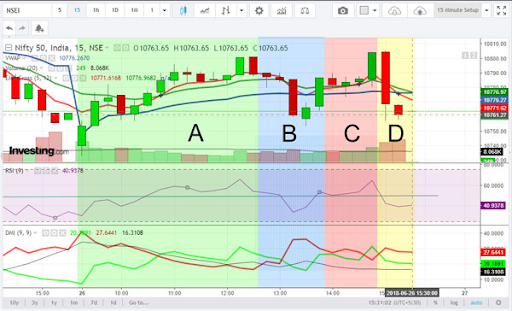Day trading or intraday trading requires traders to be quick decision-makers and trade in short spans during a trading day. Consequently, if you are an intraday trader, the intraday trading timeframe plays a key role in your trading outcomes (whether you can potentially make profits from your trades, or incur losses).
Before you start your day trading activity, you must open trading account to carry out trades. Before you consider trading timeframes and which are the most optimal, you must know some basics of day trading.
What is day trading or intraday trading?
Day trading concentrates on relatively minimal price movements within a single trading day. Day traders must open and close their positions within one trading day, and potentially aim for profits in this short timeframe.
Within a trading session, or a trading day, many timeframes are focused on by day traders. Depending on how long day traders wish to hold their positions, timeframes may be used to make trading potentially profitable. In intraday or day trading, the aim is to earn a small profit on every trade and accumulate this over time.
Intraday Trading Timeframe
In day trading, it is important to remember that choosing timeframes within which to trade depends on traders and their personalities.
Traders who wish to trade fast may make use of 1-minute timeframes, while others who do not wish to hurry may use 1-hour timeframes (so they can analyse markets and not be in a rush).
Typically, traders find a happy average timeframe in the 5-minute and 15-minute timeframes as they are neither too long nor too short for day traders.
The 5-Minute Timeframe
Intraday trading options give day traders a plethora of opportunities to make their trades potentially profitable. Some traders may commonly pick the 5-minute timeframe to trade in as it permits traders to play reversals and maintain their positions if prices tend to go in a different direction. This is a strategy that is employed when traders seek to capitalise on momentum changes in the short term. As a result, traders get to make profits from short bursts in momentum while they can still safeguard their profits with strong exit rules.
Additionally, traders use the 5-minute timeframe when trading in instruments with a high degree of volatility. Traders make just a few trades in a single day using this timeframe.
The 5-minute timeframe as displayed on a 5-minute chart, is particularly useful to traders in the first hour of a trading session as there is sufficient time between char candles for the trade to be effectively analysed and for orders to be placed.
The 15-Minute Timeframe
While opting for an intraday trading timeframe, the 15-minute chart or timeframe is also commonly used by day traders. This may be considered when day traders are attempting to determine the day’s trend.
Additionally, main entry points can be determined using such a chart. Traders can profit from relatively larger movements in price that take place throughout the day. Usually, traders find that they may be able to potentially get a few gainful trading opportunities in a single trading day with the 15-minute timeframe chart.
If traders are using this interval to decide on their trades, then they are probably those who have a sound understanding of support and resistance lines and know how to decipher candlesticks well. The 15-minute chart offers traders the chance to have a realistic view of the behaviour of the market and make decisions aligned with this.
Why You Should Prefer 5 and 15-Minute Timeframes
Day traders use many strategies to attempt to make trading profitable. Among intraday trading options, they use candlestick charts that tell them about trading time frames in which to trade during the trading day.
Before you choose any timeframes, you have to decide how much time you can commit to your trading activity in a single day. It is important to note that a 15-minute chart can be used for determining key points and the trends of prices.
A 5-minute chart is typically made use of for setting stop-loss orders and tracking positions (depending on price shifts). You may prefer any of these timeframes depending on your own style and requirements.


